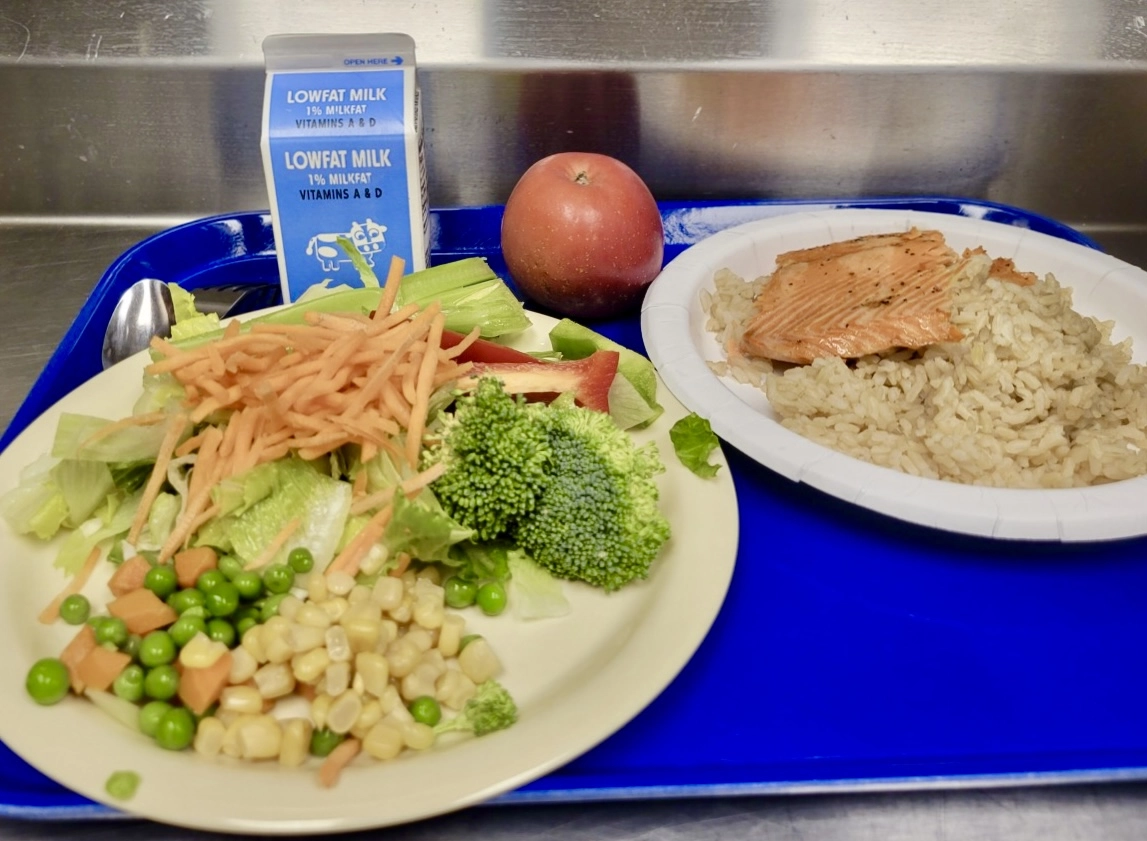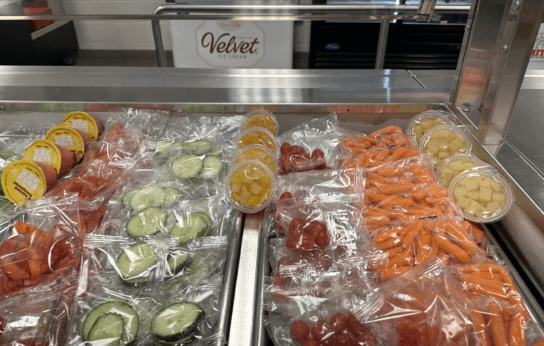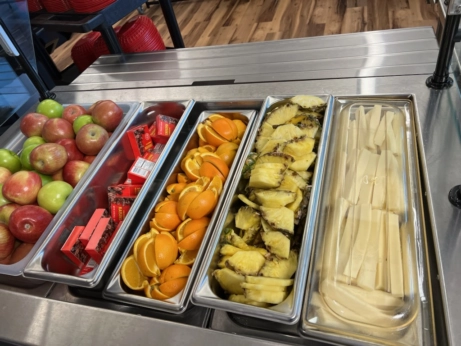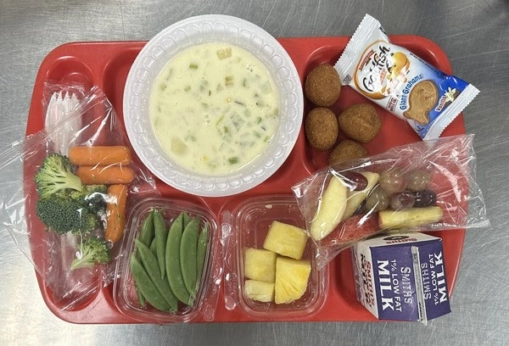On the Ground With the Schools Learning What It Takes To Improve Lunch Menus
Here’s how four trailblazing school districts are gaining traction, from getting buy-in from kids to upping creativity in the kitchen.
On the Ground With the Schools Learning What It Takes To Improve Lunch Menus
Here’s how four trailblazing school districts are gaining traction, from getting buy-in from kids to upping creativity in the kitchen.

A typical protein for Petersburg School District, in Alaska, is Sockeye salmon.submitted by Carlee Johnson McIntosh
Last month, the USDA recognized four school districts for their work in improving the nutrition standards of their lunches. That’s no easy feat, says Brandy Dreibelbis, with the Chef Ann Foundation, an organization that helps schools transition to from-scratch cooking.
Transitioning away from a system often characterized by carb-heavy, frozen and fried food can be a multi-year process, says Dreibelbis, and it starts with an in-depth assessment. “[Is the district] cooking anything at all? Are they buying everything prepackaged?” says Dreiblebis. “Do you have the equipment that you need to start cooking from scratch, even smallwares like cutting boards and knives? Some districts don’t even have that.”
From there, small changes add up to make a big difference: More than 28 million lunches are served every day in schools across the US, and for some students, that lunch is their most nutritious meal of the day. For schools with a breakfast program, evidence suggests that students who eat breakfast at school score higher on tests. But schools are up against many roadblocks, from staffing challenges to rising food costs.
Changing a school’s lunch program takes time, resources and commitment. Modern Farmer spoke with the four trendsetting schools to find out how they’ve made changes in their school lunches, what’s working and what the kids are saying about their new favorite foods.

Lowering the pressure
“I was just reading that one in six kids have high blood pressure,” says Julie Udelhofen, food service director at Clear Lake Community School District in northern Iowa. “Sodium is an issue; so is sugar. We see it every day.”
For Udelhofen, the health of the roughly 1,450 kids in her schools is a top priority, with sodium a particular issue. To combat the rise of sodium, Udelhofen has made two major changes. First, she’s moved away from pre-packaged and frozen foods as much as possible and brought in local fruits and vegetables, conducting taste-tests with her students. “We’ve done beets, kohlrabi, rutabaga and parsnips. We had all kinds of radishes, and about 10 different varieties of peppers, and the kids go down the line and pick their favorites,” says Udelhofen. The key, she says, is to introduce these foods in a low-pressure environment, making it a game of sorts. “It’s a lot of fun, because the kids are wholly invested in it. They will stop and taste things and talk to us.”
Behind the scenes, Udelhofen and her team have drastically cut sodium levels by making their own spice blends, which have been a big hit with the kids. “That’s one of the best things we’ve done, especially in the middle school and high school.” They offer a garlic and herb blend, along with Greek and Italian seasonings that kids can add to their meals, without the heaping helping of sodium from traditional blends.

Broccoli at breakfast
Most adults are probably not grabbing broccoli at breakfast, but somehow, Tina Kindelberger, food service supervisor at Sandy Valley Local School District in eastern Ohio, has turned the children in her schools into broccoli fiends.
“It’s so cute when they do that,” says Kindelberger. “I see kids walking in here with packs of broccoli, and it’s 7:30 am.”
Kindelberger started her team’s transition to scratch cooking by first just making raw fruits and vegetables available to the kids at each meal. Rather than change everything they were cooking at once, they just added in a case in the cafeteria with packages of produce such as carrot sticks, tomatoes, snap peas, bananas, apples and yes, broccoli. “The kids seem to be excited when we bring out new things and try new things. I had plums out one day, and I couldn’t believe how many kids asked me what they were. They’d never seen a plum,” says Kindelberger. But they’re now primed to try these raw fruits and veggies, which also means they’re more willing to try the cooked options as the district moves to scratch cooking.
Kindelberger and her team feed about 700 students a day, from kindergarten to high school, and each age group has different tastes and preferences. For her, the first step to changing the menu was consulting with the kids. “I meet with [students] on a regular basis, and we get a lot of feedback,” she says. One request, from the older students, was a breakfast smoothie station. So, Kindelberger got a grant for a blender, and now there are fresh fruit smoothies. “The biggest thing is getting your kids involved, getting their opinions, because it does matter. They want to be heard.”

Spaghetti and moose balls
Local food looks a lot different in parts of Alaska than in much of the rest of the US. While many school districts are working with beef and potatoes, Carlee Johnson McIntosh, the food service director in the Petersburg School District in Southeast Alaska, has a freezer full of Sockeye salmon and moose meat. For her, working with local farmers sometimes means getting food delivered by boat from neighboring island farms.
Her commitment to eating and preparing local foods started from a young age; Johnson McIntosh has allergies and was always looking for ways to alleviate and control her symptoms, so she became interested in what she was eating. Now that she supervises 450 students at her schools, she’s especially committed to ensuring they have high-quality and freshly prepared options. She’s spent the last decade advocating for changes at the school level, from altering when kids can eat breakfast to updating the kitchen facilities to allow for more scratch cooking.
“Previously, the mealtimes were crammed together. The breakfast was before school and almost nobody showed up. Now, we’re after the bell,” and kids actually show up for breakfast, she says. She’s also had to push the district on purchasing more raw food and getting her staff certified to do more than just reheat frozen packages. “My first step was to talk to our health authority and see where our deficiencies are. Why is it that we are not adequately meeting a restaurant standard? We are feeding an at-risk population, so we should be held to the same standards [as other facilities].”
That required some creativity on her part. While previous frozen options might be chicken nuggets, for Johnson McIntosh, local proteins are more likely to be moose, herring eggs or Sockeye salmon. So, that’s what they have. Now, the kids are chowing down on moose stroganoff or spaghetti and moose-balls, along with a daily salad bar.

One-bite policy
Not every new menu item is going to be a hit. Denise Tapley-Proctor, food service director at Regional School District 89 in Maine, knows that well. As she’s moved her team over to scratch cooking, there have been some fantastic wins and some less-than-stellar reviews. “We did a vegetable panini that the adults in the school system really liked and the high school kids were OK with. But the little kids were like, ‘no, don’t put vegetables in my grilled cheese.’ It was just a no go.”
But that’s all part of the process, says Tapley-Proctor. One of the staff on her food service team introduced the “no thank you bite” policy when introducing a food of the month. You don’t have to eat the whole thing, but you have to take one bite to try it. Plus, you get a sticker if you do.
The one-bite policy has been a great help to Tapley-Proctor and the team while they feed about 225 students a day. It’s allowed them to take a gradual approach with the changes, phasing in one new meal or even one new ingredient at a time.
“Instead of bringing the box of instant potatoes, see how much longer it takes and how much better the flavor is [to make your own],” she says. “If we have leftover rolls from the day before that we didn’t serve the kids, if you cut them up and throw some spices on them, bake them in the oven, you have homemade croutons, and the kids are excited to put it on the top of their meal. It’s the little things that lead to the big thing.”
They’ve also started working with local farmers, teaching kids how plants grow. “We’ve learned that if the children have a stake in it somehow, like if they grow the food, they’re more apt to want to eat it,” she says. They’ve grown tomatoes in the school garden, then used the after-school program to make a salsa, which went on the menu the next day. “The kids were like, ‘this is our salsa,’” she says.
Tapley-Proctor says it’s been a process for the staff as well. She’s helped them get training from the Chef Ann Foundation on kitchen skills and learning new recipes. But even with extra effort, she says the feedback from the kids is what makes it worth it. While serving a chicken pot pie, one of the students told them that it “made her belly happy.” Another boy was having a bad day, and then had some fresh watermelon with lunch. “This makes me think of summer and fireworks,” he said. “He had gone from a bad mental health day to a good mental health day because of the food.”

Care about your cafeteria? Here’s how to get involved
The USDA will finalize proposed legislation around school lunches this month, with updates to its nutrition standards and exceptions for local and traditional foods. In the proposed changes, schools would have to reduce sodium levels, limit added sugars and would be allowed to use locally grown, raised or caught food that has been minimally processed in their menus. Updates will be phased in over the next five years, with the first changes coming to menus in the fall of 2024.
If you have kids in school and are interested in helping bring about changes in your own district, everyone Modern Farmer spoke with recommended reaching out to the food service director at your school to find out what kinds of foods the school is working to introduce to kids and how. They’re the ones that feed your kids every day and can speak about their goals when it comes to nutrition. Some schools will even welcome parents to join their kids for a lunch period, to get a first-hand look at what’s on offer.
You can also get involved at the state level, organizing around campaigns such as Healthy School Meals for All. For a list of what’s happening in your state, check out this map from the National Farm to School Network.
And if you work in a school district, Dreibelbis advises that you make the switch to scratch cooking one step at a time. Take a cafeteria classic: boxed macaroni and cheese. You can change one element at a time, such as purchasing a pre-mixed cheese sauce but cooking your own pasta. Once that’s second nature, add one more element. “If you’re making something like a homemade cheese sauce, you’re using flour, butter, milk, cheese and salt. And right there alone, you’re going from what was probably 30 ingredients to five.”
Follow us
This work is licensed under a Creative Commons Attribution-NoDerivatives 4.0 International License.
Want to republish a Modern Farmer story?
We are happy for Modern Farmer stories to be shared, and encourage you to republish our articles for your audience. When doing so, we ask that you follow these guidelines:
Please credit us and our writers
For the author byline, please use “Author Name, Modern Farmer.” At the top of our stories, if on the web, please include this text and link: “This story was originally published by Modern Farmer.”
Please make sure to include a link back to either our home page or the article URL.
At the bottom of the story, please include the following text:
“Modern Farmer is a nonprofit initiative dedicated to raising awareness and catalyzing action at the intersection of food, agriculture, and society. Read more at <link>Modern Farmer</link>.”
Use our widget
We’d like to be able to track our stories, so we ask that if you republish our content, you do so using our widget (located on the left hand side of the article). The HTML code has a built-in tracker that tells us the data and domain where the story was published, as well as view counts.
Check the image requirements
It’s your responsibility to confirm you're licensed to republish images in our articles. Some images, such as those from commercial providers, don't allow their images to be republished without permission or payment. Copyright terms are generally listed in the image caption and attribution. You are welcome to omit our images or substitute with your own. Charts and interactive graphics follow the same rules.
Don’t change too much. Or, ask us first.
Articles must be republished in their entirety. It’s okay to change references to time (“today” to “yesterday”) or location (“Iowa City, IA” to “here”). But please keep everything else the same.
If you feel strongly that a more material edit needs to be made, get in touch with us at [email protected]. We’re happy to discuss it with the original author, but we must have prior approval for changes before publication.
Special cases
Extracts. You may run the first few lines or paragraphs of the article and then say: “Read the full article at Modern Farmer” with a link back to the original article.
Quotes. You may quote authors provided you include a link back to the article URL.
Translations. These require writer approval. To inquire about translation of a Modern Farmer article, contact us at [email protected]
Signed consent / copyright release forms. These are not required, provided you are following these guidelines.
Print. Articles can be republished in print under these same rules, with the exception that you do not need to include the links.
Tag us
When sharing the story on social media, please tag us using the following: - Twitter (@ModFarm) - Facebook (@ModernFarmerMedia) - Instagram (@modfarm)
Use our content respectfully
Modern Farmer is a nonprofit and as such we share our content for free and in good faith in order to reach new audiences. Respectfully,
No selling ads against our stories. It’s okay to put our stories on pages with ads.
Don’t republish our material wholesale, or automatically; you need to select stories to be republished individually.
You have no rights to sell, license, syndicate, or otherwise represent yourself as the authorized owner of our material to any third parties. This means that you cannot actively publish or submit our work for syndication to third party platforms or apps like Apple News or Google News. We understand that publishers cannot fully control when certain third parties automatically summarize or crawl content from publishers’ own sites.
Keep in touch
We want to hear from you if you love Modern Farmer content, have a collaboration idea, or anything else to share. As a nonprofit outlet, we work in service of our community and are always open to comments, feedback, and ideas. Contact us at [email protected].by Emily Baron Cadloff, Modern Farmer
April 16, 2024
Modern Farmer Weekly
Solutions Hub
Innovations, ideas and inspiration. Actionable solutions for a resilient food system.
ExploreExplore other topics
Share With Us
We want to hear from Modern Farmer readers who have thoughtful commentary, actionable solutions, or helpful ideas to share.
SubmitNecessary cookies are absolutely essential for the website to function properly. This category only includes cookies that ensures basic functionalities and security features of the website. These cookies do not store any personal information.
Any cookies that may not be particularly necessary for the website to function and are used specifically to collect user personal data via analytics, ads, other embedded contents are termed as non-necessary cookies.